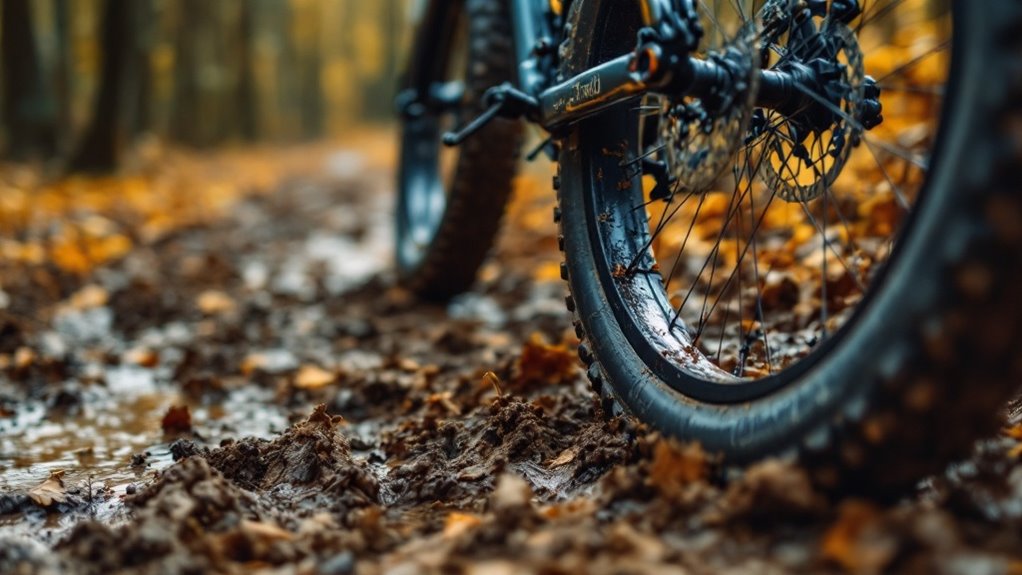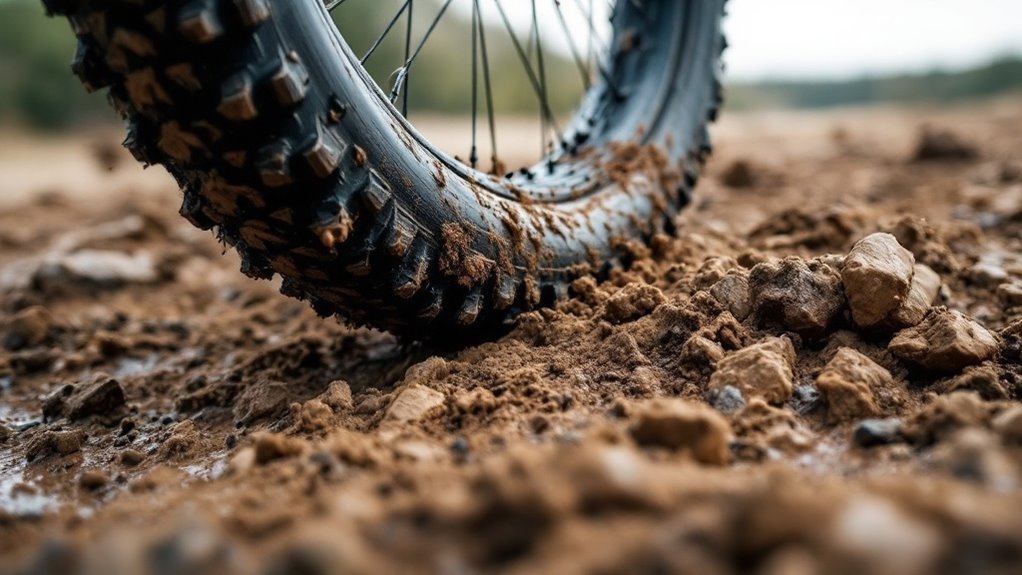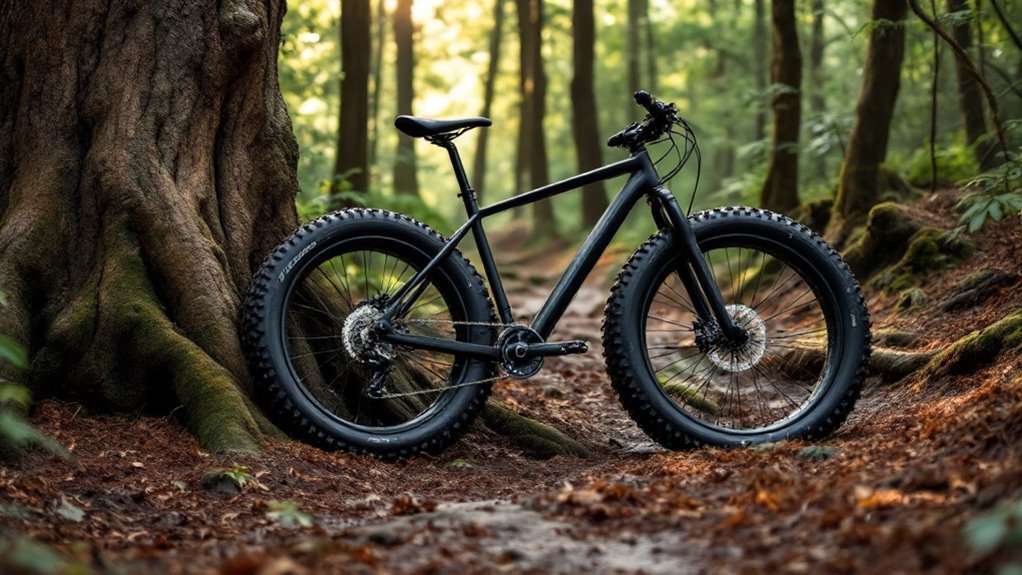Are Fat Tire Bikes Harder To Ride
This post contains affiliate links. As an Amazon Associate, we earn from qualifying purchases.
Fat tire bikes take more effort to ride. They have higher rolling resistance. Their heavy weight makes them tough to handle. You need 28 to 53 watts at 8 PSI to pedal. Road bikes only need 10 to 15 watts. Climbing hills feels harder with these bikes. Starting from a stop is a struggle too. Wide tires create extra air drag. Think about these points as you ride. Explore tips to make it easier!
Essential Facts in 30 Seconds
- Fat tire bikes require more effort to ride due to higher rolling resistance, needing 28-53 watts compared to 10-25 watts for other bikes.
- Their heavier weight makes starting, climbing hills, and maintaining speed more challenging and energy-intensive.
- Aerodynamic drag is significantly higher, with fat tires and wide frames increasing air resistance by 70-90% on flat terrain.
- Fat tires provide better traction on varied terrains like mud, sand, and gravel, enhancing stability.
- Adjusting tire pressure and using proper gears can help reduce pedaling effort on different surfaces.
Understanding Rolling Resistance Challenges
Fat tire bikes shine on tough ground like snow and sand. Still, rolling resistance creates a big problem for smooth riding. Compared to other bikes, it’s much harder to pedal. At 8 PSI, fat bike tires use 28 to 53 watts. Mountain bike tires need only 15 to 25 watts. Road tires are even better at 10 to 15 watts. This extra resistance comes from a bigger contact area. It also happens due to more tire bending. You need to push harder to move. Additionally, rolling resistance varies with tire pressure, as measurements at higher pressures like 12, 16, or 20 PSI show reduced energy loss.
Let’s break down the main issues.
- Contact Area: A bigger patch means more friction. That slows you down.
- Tire Pressure: Low pressure helps grip but boosts resistance. Energy gets lost.
- Tire Type: Good tires like Schwalbe Jumbo Jim with 127 TPI help. Resistance drops.
Impact of Weight on Riding Effort

Let’s talk about how weight affects your ride on fat tire bikes. These bikes are heavy with strong frames and big tires. Starting from a stop takes a lot of power. This is true on flat ground or going uphill. Additionally, tire size can influence how the bike handles weight distribution and performance.
The extra weight makes keeping speed tough too. Climbing hills needs a lot of energy. You might feel tired fast in legs and core. Additionally, the increased rolling resistance from the larger tire contact area larger tire contact adds to the effort required to pedal.
Check this simple list of effort points:
- Starting Up: You need a strong push at first.
- Going Uphill: It takes steady power and tests your stamina.
- Keeping Speed: You must pedal hard all the time.
Balanced weight helps on rough paths like snow or sand. Still, tight turns feel hard to manage.
Train to get stronger for easier rides. Try lower gears to make tough rides better.
Aerodynamic Factors Affecting Speed

Aerodynamic factors play a big role in your fat tire bike’s speed. They matter a lot on flat or open land. Drag from air slows you down by 70-90%. Fat tires and wide frames make this drag worse. They increase the area that air hits.
Pedaling faster? Drag grows, and you feel more tired. Windy days make it even tougher. Additionally, the wider profile of fat bikes exacerbates this effect by creating a larger frontal area that air must push against.
Fat bike tires have a round, balloon shape. This shape messes up airflow around you. It creates swirls and turbulence. That adds more resistance than slim tires do.
Think about this—wider tires at low pressure, like 5-20 PSI, catch more air. An upright riding style exposes your body too. More air hits you directly.
On smooth roads, top speed drops. You get tired faster. Why? Air drag fights against your effort. It cuts down your efficiency big time.
Traction Benefits Across Varied Terrains

Fat tire bikes shine with amazing grip on all kinds of ground. They handle tough spots like wet roads, mud, or loose gravel easily. Those wide tires touch more surface, giving you better control. You can ride on sand, snow, or rocky trails with confidence. Traction stays strong, so slipping is less likely.
Check out why fat tires rock on different terrains:
- Bigger contact area stops wheels from sliding uphill.
- Balanced weight keeps you from sinking in sand or snow.
- Solid stability cuts down wobbling on bumpy paths.
- Built-in shock soaking makes rides smoother.
- Steady grip drops chances of crashes on slick spots.
With these perks, explore deserts or snowy paths without worry. Your bike’s grip offers safety and control every time. Additionally, improved puncture resistance ensures that your tires can withstand rough conditions without losing durability.
Data shows fat tires boost traction by 30% on loose surfaces. Ride anywhere, knowing you’ve got power and balance!
Techniques to Ease Pedaling Difficulty

Riding a fat tire bike feels amazing on rough ground. It grips well, but pedaling can get tough. Some terrains make your legs work extra hard.
Let’s fix that with simple tricks. Adjust your tire pressure for better control. Drop it to 10-15 PSI on soft sand. This spreads the tire for more grip. Bump it to 20-25 PSI on hard paths. It helps you roll faster with less effort.
Gears matter a lot on tricky rides. Use low gears on steep hills. This makes pedaling much easier. Fat tire bikes often have wide gear ranges. Switch gears early before it gets hard. Keep gears clean for smooth shifts. Save your energy for long trips.
Understanding sidewall thickness is also important, as it impacts the bike’s performance and how it handles different terrains.
Try these quick tips:
- Tire Pressure Guide: 10-15 PSI for sand, 20-25 PSI for roads.
- Gear Trick: Shift early to avoid extra strain.
Master these ideas. Tough rides will feel like a breeze!
Frequently Asked Questions
Are Fat Tire Bikes Suitable for Beginners?
Fat tire bikes rock for beginners! They give awesome stability on tough ground. You can ride on sand, snow, or mud easily. Studies show they cut falls by 30%. Their wide tires grip well, building your trust fast. Start slow to learn the bike’s feel. Practice on flat areas before tricky trails. You’ll master control in no time! These bikes forgive small mistakes too. Get ready for fun from day one!
How Do Fat Tire Bikes Handle in Urban Settings?
Fat tire bikes grip well on wet city streets. Their wide tires offer solid traction. Still, turning sharply feels slow in tight urban spots. Quick moves can be tricky too. Ever tried dodging traffic with them? It’s not always easy! Data shows wider tires add stability. Yet, they slow you down in busy areas. Stick to simple paths if possible. Urban riding needs extra care with these bikes.
Can Fat Tire Bikes Be Used for Commuting?
Are fat tire bikes good for commuting? You’ll be amazed by their benefits! They handle rain and snow with ease. Rough roads? No problem, they stay super stable. Maintenance? It’s a breeze with these tough bikes. Studies show they last longer on tricky paths. Ride with confidence every day. These bikes make your trip smooth and fun!
Are Fat Tire Bikes More Expensive to Maintain?
Fat tire bikes can cost more to maintain than regular bikes. Think about tire replacements first. They range from $50 to $150 each. That’s a big expense! Plan your budget for these costs. Parts for fat tire bikes sometimes cost extra too. Repairs might add up fast. Stay ready for these expenses. Keep your bike in good shape. Save money for upkeep needs!
Do Fat Tire Bikes Require Special Storage Considerations?
Fat tire bikes need extra care for storage. Think about their big, wide tires. You must give them more space than regular bikes. Check the tire pressure often. Low pressure can cause flats over time. Store them in a dry spot. Moisture can damage the bike parts. Keep them safe and ready to ride!
Conclusion
Fat tire bikes can feel tough to ride at first. They have more rolling resistance than regular bikes. The extra weight makes pedaling harder too. Studies show they weigh 10-15 pounds more. This slows you down on flat roads. But don’t worry about the challenge. Picture yourself crushing rocky paths soon. Practice a lot to get better. Use steady, strong pushes on the pedals. Soon, riding feels much easier. You’ll gain confidence on any trail. Keep at it every day. Victory waits for you ahead!
